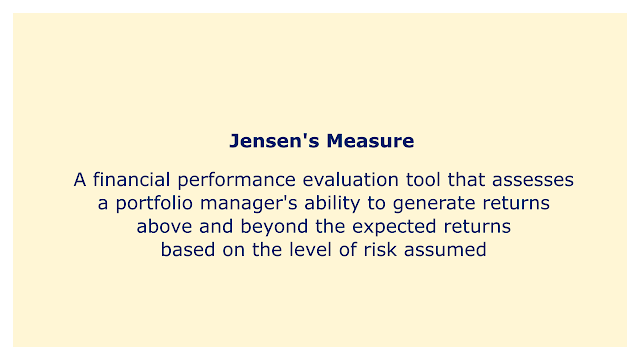 |
| Image: Moneybestpal.com |
A financial performance evaluation measure called Jensen's Measure evaluates a portfolio manager's capacity to produce returns above and beyond those anticipated given the level of risk taken. Michael Jensen, a well-known economist, and professor of finance at Harvard University created it in 1968.
The index compares the portfolio's actual return to its projected return based on the securities market line (SML), a graphical representation of the capital asset pricing model (CAPM), while also accounting for the systematic risk or beta of the portfolio.
Jensen's Measure formula is defined as the difference between the expected return and the actual return on the portfolio, where the expected return is calculated as the risk-free rate plus the portfolio's beta times the excess market return. Alternatively, put:
Jensen's Measure = Portfolio Return - [Risk-free Rate + Beta(Portfolio) x (Market Return - Risk-free Rate)]
A positive Jensen's Measure implies that the portfolio manager has outperformed expectations given the level of risk assumed, whereas a negative measure shows underperformance.
In the financial sector, Jensen's Measure is frequently used to assess the performance of managed investment portfolios like mutual funds, hedge funds, and others. It has, however, also drawn criticism for relying on the CAPM, which has restrictions on its underlying assumptions and application to actual markets.
Jensen's Measure formula is defined as the difference between the expected return and the actual return on the portfolio, where the expected return is calculated as the risk-free rate plus the portfolio's beta times the excess market return. Alternatively, put:
Jensen's Measure = Portfolio Return - [Risk-free Rate + Beta(Portfolio) x (Market Return - Risk-free Rate)]
A positive Jensen's Measure implies that the portfolio manager has outperformed expectations given the level of risk assumed, whereas a negative measure shows underperformance.
In the financial sector, Jensen's Measure is frequently used to assess the performance of managed investment portfolios like mutual funds, hedge funds, and others. It has, however, also drawn criticism for relying on the CAPM, which has restrictions on its underlying assumptions and application to actual markets.
